Sago palms look exotic and difficult to care for, but they are surprisingly simple to grow. In this detailed guide, you’ll learn everything you need to know about how to keep them thriving indoors or outside.
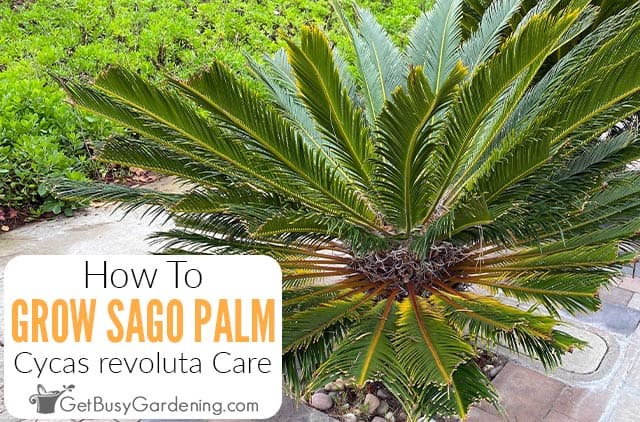
Though they are very popular landscaping plants in warm regions, sago palms also make excellent houseplants.
They are low maintenance and very forgiving, making them an excellent choice for beginners and experts alike.
Below I’ve shared everything you need about sago palm care. You’ll get tips on basics like water, light, and soil, as well as advanced info for pruning, propagation, repotting, and much more.
Information About Sago Palms
Though they look like palm plants, sagos, or Cycas revoluta, technically are not. Instead they’re from the ancient Cycad family that dates back to prehistoric times.
They’re native to Japan and China, and known for their crown of wide, feathery fronds that sprout from thick trunks.
These slow growers sometimes add as little as one frond per year. But, over time they can reach a stunning 6’ tall and 8’ wide. Indoors however, it’s rare for them to exceed 2-3’.
Different Cycas revoluta Types
There are a few others from the same family that are also called sago palms, but differ from the Cycas revoluta in a few ways.
- Cycas circinalis – The fronds grow higher on the trunk on these 10’ specimens.
- Cycas rumphii – These are more tree than shrub-like and grow to a towering 15’.
Flowers
Though sago palms don’t flower in the way you might expect, mature plants will produce cones that are key for reproduction.
Males develop 12-24” cones that pollinate the basket-shaped, seed-bearing cones that form on the females.
It can take anywhere from 10-15 years for Cycas revoluta to grow large enough to flower. Even then, they’ll only bloom outdoors in ideal conditions once every 3 years. It’s very uncommon for them to bloom indoors.
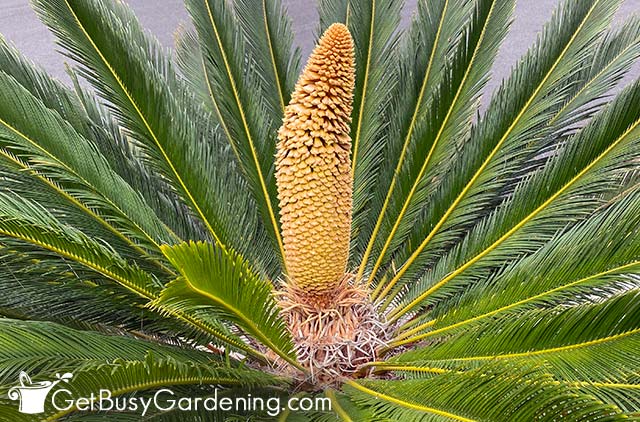
Sago Palm Toxicity
Unfortunately all parts of the sago palm are poisonous when ingested. According to the ASPCA website, cats and especially dogs can experience illness from eating any part of the plant, but the seeds in particular are highly toxic.
Make sure you quickly dispose of any seed pods as they develop. It’s also a good idea to keep the plant away from your pets and small children.
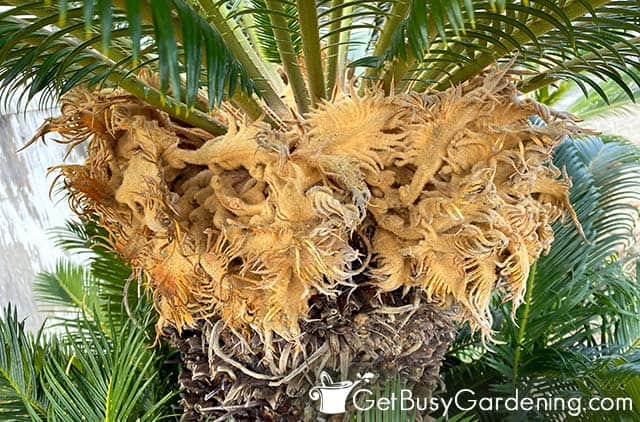
How To Grow Sago Palm
Before we talk about sago palm care, first let’s chat about the best place to grow one. Choosing an ideal location can keep them thriving for many, many decades.
Hardiness
As a tropical plant, sago palms prefer warmth and humidity, and grow best outdoors in zones 8-11. Outside of those areas, they need to be brought indoors and kept as houseplants.
Repeated exposure to freezing temperatures or extreme heat can cause leaf damage, and will eventually kill the plant.
Where To Grow Sago Palms
In warm climates sago palms make a fantastic landscaping choice in partially shaded areas protected from the afternoon sun.
For the rest of us, it’s best to grow them in containers like your other palm houseplants, or at least overwinter them indoors.
They don’t like soggy or heavy soil. Terracotta pots with drainage holes are a popular choice to help them stay on the dry side.
Give them plenty of room to promote good airflow around the foliage. Also place them in a spot away from heaters or air conditioning vents. Extreme temperature swings can damage the fronds.

Sago Palm Tree Care & Growing Instructions
Now that you’ve picked out the best location for your sago palm tree, it’s time to learn how to care for them. Here are my best tips for keeping yours thriving.
Light
Outdoors they do best with full to partial sunlight. If they get too much shade the plant will grow very slowly and may become leggy.
Indoors, place your sago near a bright window that gets lots of sun – like a south or west facing window. If your house is dark, add a grow light to prevent the foliage from getting sparse.
Water
Sago palms prefer moderately moist soil to grow their best, but are very sensitive to root rot. Water deeply when the top few inches has dried out, and drain off all the excess.
It’s best to water the root area rather than streaming it directly on the trunk or foliage to prevent rot. If you struggle to get it right, a moisture meter is a great tool that will help you.
Outdoors, normal rainfall is typically all they’ll need. But in dry or very hot conditions, water deeply near the trunk with a slow flowing hose to prevent wilting.
Humidity
They’re native to humid regions and will develop brown tips in extremely dry conditions.
Provide extra humidity for your indoor sago palm tree by misting lightly, setting it on a pebble tray filled with water, or running a humidifier nearby.

Temperature
They prefer temperature ranges between 55-75°F, and will suffer leaf damage or drop when exposed to extreme heat or cold.
Bring your sago palm indoors for the winter before freezing temperatures set in.
For outdoor Cycas revoluta, mulching the base or covering the plant with burlap or a frost blanket can help them survive short cold snaps.
Fertilizer
Fertilizer is an important part of sago palm care. They’re sensitive to nutrient deficiencies, and giving them the occasional feeding will boost frond color and encourage flowering.
Add balanced slow-release granules once during the spring and summer, or use a liquid fertilizer monthly until winter. A natural palm formula works well too.
Outdoors, gently working in organic compost is a great option too. Avoid any chemical options however, as they can burn and damage the leaves.
Soil
The ideal soil for growing sago palm plants is porous, rich, and well-draining. You can buy a mix or create your own by combining equal parts general purpose potting soil with perlite and coarse sand.
Outdoors, amend hard clay with sand to lighten it up, or mix compost into sandy soil to make it richer in organic matter.
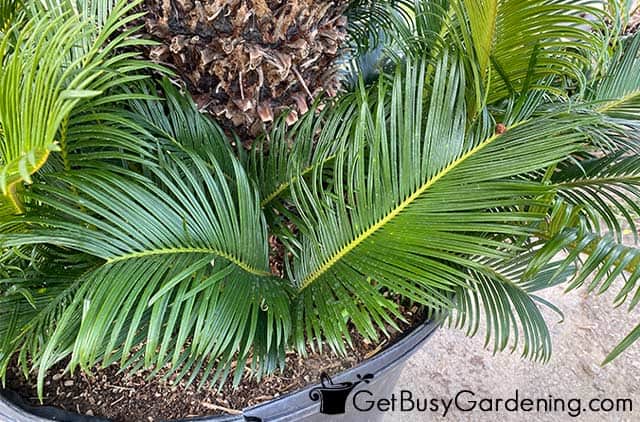
Transplanting & Repotting
Repotting isn’t needed very often for the slow-growing sago palm. Once every 2-3 years, check if yours has roots coming from the drainage holes. If so, it’s time to size up.
If it’s been longer than a few years, you can replace the top few inches of soil to replenish nutrients, rather than repotting.
When transplanting outdoors, ensure the top of the rootball is no deeper than the soil line to prevent water from building up around the base. Don’t fertilize it for 2-3 months afterward while it settles in.
Pruning
Pruning isn’t a required part of routine sago palm care, but you can trim away damaged fronds, or shape it through gradual cuts.
Use sharp pruners to trim the fronds as close to the trunk as possible. If you’re shaping yours, take only a few fronds at a time to prevent stressing the plant.
It’s also important to know that old leaves will yellow and die back over time. Wait until they’re fully brown to remove them. Until then they’re still vital to the plant, and cutting them off can stunt growth.
Pest Control Tips
With the proper care, healthy sago palms don’t have a lot of pest issues. But from time to time, scale, mealybugs, or spider mites could become a problem.
They can be treated with natural solutions like insecticidal soap or neem oil. To gain the upper hand, you could trim away heavily infested fronds as well, but don’t remove too many at once.
You can make your own insecticide by combining 1 teaspoon of mild liquid soap with 1 liter of water. Avoid chemical products to reduce the chances of burning or damaging it further.
Related Post: How To Care For Cat Palm (Chamaedorea cataractarum)
Sago Palm Propagation Tips
Sago palms can be propagated either from seeds or by division.
Seeds take a very long time to mature into a sizable plant. So most gardeners prefer to multiply them by harvesting the pups that develop around the base.
They’re easy to remove with gentle wiggling when they’re small. Large ones may require a sharp, clean knife. Let the wound callus for a few days, then plant into well-draining soil.
Water thoroughly and place in a shaded area until roots develop. This can take several months.
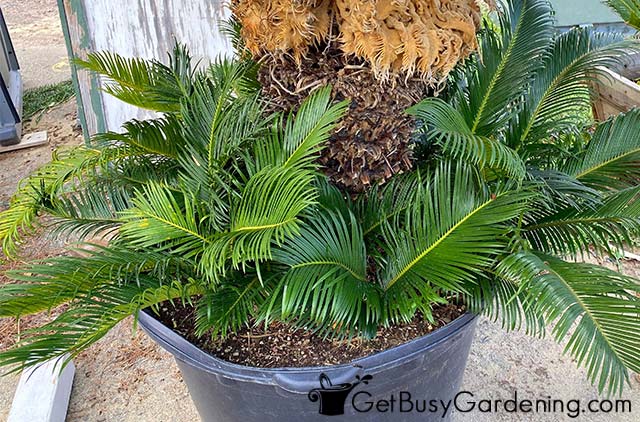
Troubleshooting Common Sago Palm Care Problems
As a plant that can live for 50 or more years, you might occasionally run into one of these common sago palm care issues. Use these tips to help get yours healthy again.
Brown Leaves
Brown leaves can happen from sun exposure, lack of humidity, or age. Protect them from the direct sun, especially during the hottest part of the day.
If your home or climate is very dry, provide them with some added moisture or humidity to prevent brown tips.
However the occasional brown lower leaf is a natural part of the life cycle, and nothing to worry about.
Sago Palm Turning Yellow
Yellow leaves on a sago palm is a sign of improper watering, transplant shock, or root rot.
Overwatering can cause soggy, wilting leaves, and a soft, mushy trunk. While too little water can cause a faded appearance, and eventual leaf drop.
If you’ve recently transplanted, give it a little time to recover. Don’t remove the yellow fronds until they turn brown.
Leaves Turning Yellow
Leaves most commonly turn yellow on a sago palm due to overwatering, mineral deficiency, or age.
If they’re soft, let the soil dry out more between drinks. Magnesium deficiency is also a common cause however, so make sure you’re applying a balanced fertilizer once a month during the spring and summer.
As the foliage ages the leaves become naturally yellow and then brown. Don’t remove them if it’s only the occasional old leaf, it’s still feeding the plant.
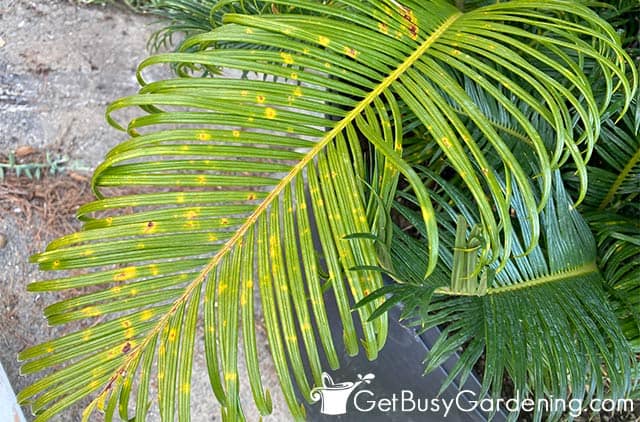
Sago Palm Care FAQs
Here I’ve answered some of the most commonly asked questions about sago palm plant care. If yours isn’t listed here, please add it to the comments section below.
Can sago palms be indoor plants?
Absolutely sago palms can be indoor plants. In fact, they make great houseplants, and grow well in containers with plenty of bright light.
How fast do sago palms grow?
Sago palms don’t grow fast at all, they are very slow, especially indoors. In ideal conditions, it can take them over a decade to reach full maturity.
How tall does a sago palm tree grow?
Outdoor sago palm trees can grow to heights of 6’ or taller. Indoors, it’s more common for them to only reach 2-3’.
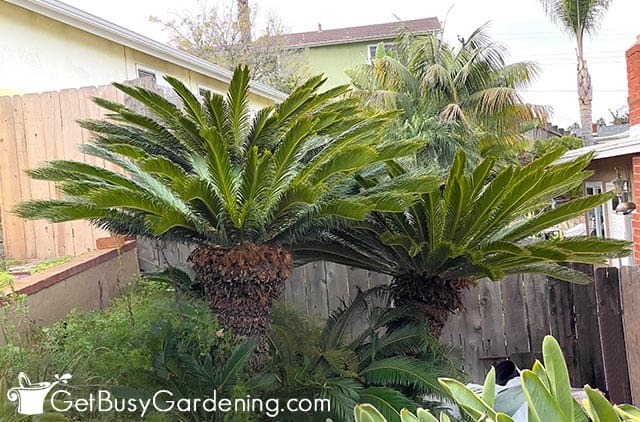
Are sago palms poisonous?
Yes, all parts of sago palms are poisonous to animals and humans if ingested, especially the seeds.
Do sago palms do well in pots?
Yes, sago palms do well in pots with good drainage. They can be grown either indoors or outdoors in containers.
Does Cycas revoluta like full sun or shade?
Cycas revoluta likes partial shade. Ideally they should get sun in the mornings and evenings, with some shade during the hottest part of the day. Direct sun all day long can burn the fronds.
The sago palm is a great plant that is easy to care for indoors or outside. With these growing tips you’ll be able to maintain your Cycas revoluta for many decades to come.
If you want to learn all there is to know about maintaining healthy indoor plants, then you need my Houseplant Care eBook. It will show you everything you need to know about how to keep every plant in your home thriving. Download your copy now!
More Houseplant Care Guides
- How To Care For Fiddle Leaf Fig Plant (Ficus lyrata)
- How To Take Care Of A Money Tree Plant (Pachira aquatica)
- How To Care For Dracaena marginata (Madagascar Dragon Tree)
- How To Care For Staghorn Fern (Platycerium bifurcatum)
- How To Care For A Philodendron Birkin Plant
- How To Care For Foxtail Fern (Asparagus densiflorus ‘Myers’)
Share your sago palm care tips in the comments section below.






Karen Somers says
My sago palm is about 10 years old. I re-potted it last year for the first time and it has been doing well. This spring it started developing 5 new fronds (I’ve only seen 3 in the past) but they are very long and spindly and taking forever to open. They are at least twice the length of the existing leaves, and it is making the palm look very odd. What can I do at this point to help it look more normal. I want to cut this new growth off but that does not seem like a good idea to me. Any suggestions would be welcomed. Thank you, Karen
Amy Andrychowicz says
I don’t recommend cutting the leaves off – it’s best to keep them on the plant. I’m guessing the reason they’re growing leggy is that your sago isn’t getting enough light. They do best in full to partial sun outdoors, and near a sunny window or under a grow light indoors. If yours is getting plenty of light, then check the leaves for bugs. Also you may need to slow down on fertilizer – and don’t feed it at all during the fall and winter months.
Patty Thompson says
It has been over two years since this exchange. My transplanted Sago’s are doing well, but of them developed yellow spots. I see from another post that this is likely from overwatering. I will try dialing back the flow from the auto drip.
My question, I still have some Miracle Grow intended for Sago’s. Should I throw it away since you commented that it is a synthetic, or is it safe to use up and then purchase another kind of fertilizer? Thank you for your recommendations.
Amy Andrychowicz says
I personally do not like that brand, and don’t recommend using it for anything. I also don’t like using chemical fertilizers in general because it’s easy to accidentally overuse them and burn plant roots. If it were me, I would switch to an organic or natural product and toss the other stuff. But if you want to use up what you have, just make sure to follow the application instructions exactly so you don’t overdo it on your sago – in fact I would dilute it a bit more than they recommend because palms can be even more sensitive than other plants.
Scott Campbell says
Hi I have 2 big sagos that I trimmed off all the leaves and transplanted them about 1month ago maybe 2. Both of them developed cones in the middle one short and fat and the other long and slim. My question is 1 should I cut them off, 2 will they grow leaves back this year. I will say the short cone is showing signs of opening like maybe leaves are coming back? But the other is at least a 6” cone
Amy Andrychowicz says
Sagos are very slow growers, so it will likely take several months before they start getting new leaves. Especially now that they’re producing cones – they probably won’t put on any new leaves until this fall or next spring. I don’t recommend cutting off the cones. It won’t speed up leaf growth, and you could cause more harm than good. The growing point for future leaves is located just under the cone, and cutting it off could harm the plant or delay new growth even more.
Rafael says
You have the easiest guide I have found to care for sago palms, thank you.
My sago palm is starting to develop light green/yellow splotches on the leaves. I left it outside when the weather was comfortable. It became cold quickly as it got dark and I forgot about it. The leaves were frosty when I brought it back inside. Should I prune the splotchy leaves, get magnesium, or do something else?
Thanks, again.
Amy Andrychowicz says
You’re welcome, I’m so happy to hear that you found my guide so helpful! 🙂 Sago palms can handle frost, and even short periods of freezing temps – they are hardy down to zone 8b. So I don’t think that’s the problem. Yellow splotches on the leaves are usually and indication that it’s getting too much water – but it could be a nutrient deficiency or bugs. Check the soil to make sure it’s not wet, it should dry between waterings (at least 2″ deep) and inspect the leaves for bugs. If that’s not the problem, then try feeding it with a balanced organic fertilizer to see if that helps. Good luck!
Donna Bies says
the middle of my plant has a tan coating where the new fronds com from it has grown leaves for three years but none this year what is that yellow that looks like a sponge?
Amy Andrychowicz says
That is the flower cone/spike, it sounds like you have a male sago palm.
Carl R Wood says
when should you cut the cone’s off ? and my sago palm has to cone’s
Amy Andrychowicz says
You can cut the sago palm cones off once they set seeds (short/round female) or begin to dry up (tall/slender male). If you want to save the seeds, leave the female cone in place until the seeds are viable. Otherwise cut it off to prevent them from forming/maturing.
Patty Thompson says
I repotted two sago palms five days ago. One is not doing well. He is 4 ft tall and his upper frowns no longer stand upright. They have all drooped. I watered and used Miracle Grow Palm food. I left it in the same spot on the patio. Is there anything else I can do or just pray? Thank you.
Amy Andrychowicz says
Oh no, sorry to hear your sago palm isn’t doing well. It sounds like it’s in severe transplant shock after being repotted. Unfortunately the brand of fertilizer you used is likely made from synthetic chemicals, so that probably made the shock worse. Yes, at this point all you can do it leave it alone and hope it will recover. Overwatering will also make things worse. So do not water it again until the soil has completely dried out at least 2″ deep, and definitely don’t add anymore fertilizer. Good luck, I have my fingers crossed for you that it will recover!
P Thompson says
Thank you so much for your response. It rallied by the upper and mid fronds lifting up noticeably but no where near back to normal. Since then there has been no visible improvement. In fact, while green the fronds look different. It may just be lighting because of the droop. It’s not helped that we have had a lot of wind.. It is somewhat protected at the edge of the patio. Today we may get a little rain. I’m still hopeful because of its ability to rally so noticeably. It is as if it knew I was so distraught that it wanted me to know it is healing and will just take time. The pot it is in is only 3” deeper than the original. It’s in a 22” deep pot now. I will use the 2” dryness method as you instructed. Thank you again for your kindness and encouragement.
Amy Andrychowicz says
Glad to hear it’s starting to rally, hopefully it will continue to recover. You’re welcome, and good luck!
Patty Thompson says
Amy – I want to thank you for taking the time to respond to me.
My large Sago lost all but five fronds. I held out hope that since I saw it lift it’s fronds early on that it was still alive. It has been three months since I repotted the plant and it now has 20 new shoots!!!
I am thrilled beyond belief. I had resigned myself that it might be well over a year or two before I saw any new growth. What a surprise when I checked it and saw these beautiful new green babies sprouting.
I write this to encourage others.
Amy Andrychowicz says
Yay, I’m so happy to hear that your sago palm has recovered! Great job, and thanks for sharing. 🙂